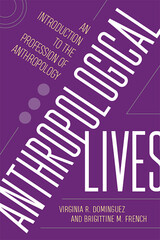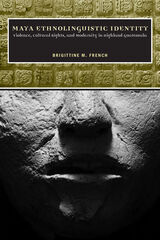2 books by French, Brigittine M.

Anthropological Lives
An Introduction to the Profession of Anthropology
Virginia R Dominguez
Rutgers University Press, 2020
Anthropological Lives introduces readers to what it is like to be a professional anthropologist. It focuses on the work anthropologists do, the passions they have, the way that being an anthropologist affects the kind of life they lead. The book draws heavily on the experiences of twenty anthropologists interviewed by Virginia R. Dominguez and Brigittine M. French, as well as on the experiences of the two coauthors. Many different kinds of anthropologists are represented, and the book makes a point of discussing their commonalities as well as their differences. Some of the anthropologists included work in the academy, some work outside the academy, and some work in institutions like museums. Included are cultural anthropologists, linguistic anthropologists, medical anthropologists, biological anthropologists, practicing anthropologists, and anthropological archaeologists. A fascinating look behind the curtain, the stories in Anthropological Lives will inform anyone who has ever wondered what you do with a degree in anthropology.
Anthropologists profiled: Leslie Aiello, Lee Baker, João Biehl, Tom Boellstorff, Jacqueline Comito, Shannon Dawdy, Virginia R. Dominguez, T.J. Ferguson, Brigittine French, Agustín Fuentes, Amy Goldenberg, Mary Gray, Sarah Green, Monica Heller, Douglas Hertzler, Ed Liebow, Mariano Perelman, Jeremy Sabloff, Carolyn Sargent, Marilyn Strathern, Nandini Sundar, Alaka Wali.
Anthropologists profiled: Leslie Aiello, Lee Baker, João Biehl, Tom Boellstorff, Jacqueline Comito, Shannon Dawdy, Virginia R. Dominguez, T.J. Ferguson, Brigittine French, Agustín Fuentes, Amy Goldenberg, Mary Gray, Sarah Green, Monica Heller, Douglas Hertzler, Ed Liebow, Mariano Perelman, Jeremy Sabloff, Carolyn Sargent, Marilyn Strathern, Nandini Sundar, Alaka Wali.
[more]

Maya Ethnolinguistic Identity
Violence, Cultural Rights, and Modernity in Highland Guatemala
Brigittine M. French
University of Arizona Press, 2010
In this valuable book, ethnographer and anthropologist Brigittine French mobilizes new critical-theoretical perspectives in linguistic anthropology, applying them to the politically charged context of contemporary Guatemala. Beginning with an examination of the “nationalist project” that has been ongoing since the end of the colonial period, French interrogates the “Guatemalan/indigenous binary.” In Guatemala, “Ladino” refers to the Spanish-speaking minority of the population, who are of mixed European, usually Spanish, and indigenous ancestry; “Indian” is understood to mean the majority of Guatemala’s population, who speak one of the twenty-one languages in the Maya linguistic groups of the country, although levels of bilingualism are very high among most Maya communities. As French shows, the Guatemalan state has actively promoted a racialized, essentialized notion of “Indians” as an undifferentiated, inherently inferior group that has stood stubbornly in the way of national progress, unity, and development—which are, implicitly, the goals of “true Guatemalans” (that is, Ladinos).
French shows, with useful examples, how constructions of language and collective identity are in fact strategies undertaken to serve the goals of institutions (including the government, the military, the educational system, and the church) and social actors (including linguists, scholars, and activists). But by incorporating in-depth fieldwork with groups that speak Kaqchikel and K’iche’ along with analyses of Spanish-language discourses, Maya Ethnolinguistic Identity also shows how some individuals in urban, bilingual Indian communities have disrupted the essentializing projects of multiculturalism. And by focusing on ideologies of language, the author is able to explicitly link linguistic forms and functions with larger issues of consciousness, gender politics, social positions, and the forging of hegemonic power relations.
French shows, with useful examples, how constructions of language and collective identity are in fact strategies undertaken to serve the goals of institutions (including the government, the military, the educational system, and the church) and social actors (including linguists, scholars, and activists). But by incorporating in-depth fieldwork with groups that speak Kaqchikel and K’iche’ along with analyses of Spanish-language discourses, Maya Ethnolinguistic Identity also shows how some individuals in urban, bilingual Indian communities have disrupted the essentializing projects of multiculturalism. And by focusing on ideologies of language, the author is able to explicitly link linguistic forms and functions with larger issues of consciousness, gender politics, social positions, and the forging of hegemonic power relations.
[more]
READERS
Browse our collection.
PUBLISHERS
See BiblioVault's publisher services.
STUDENT SERVICES
Files for college accessibility offices.
UChicago Accessibility Resources
home | accessibility | search | about | contact us
BiblioVault ® 2001 - 2024
The University of Chicago Press









